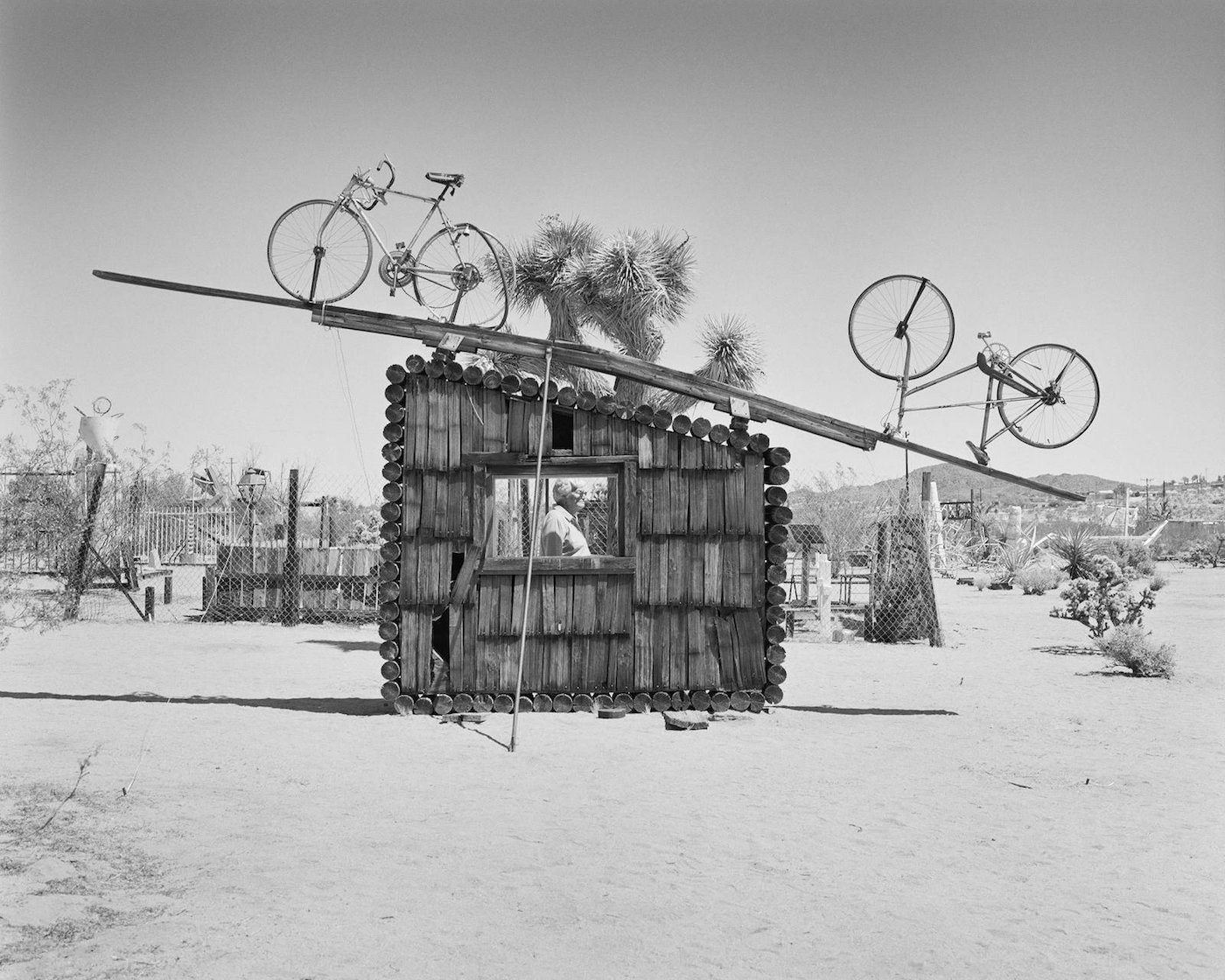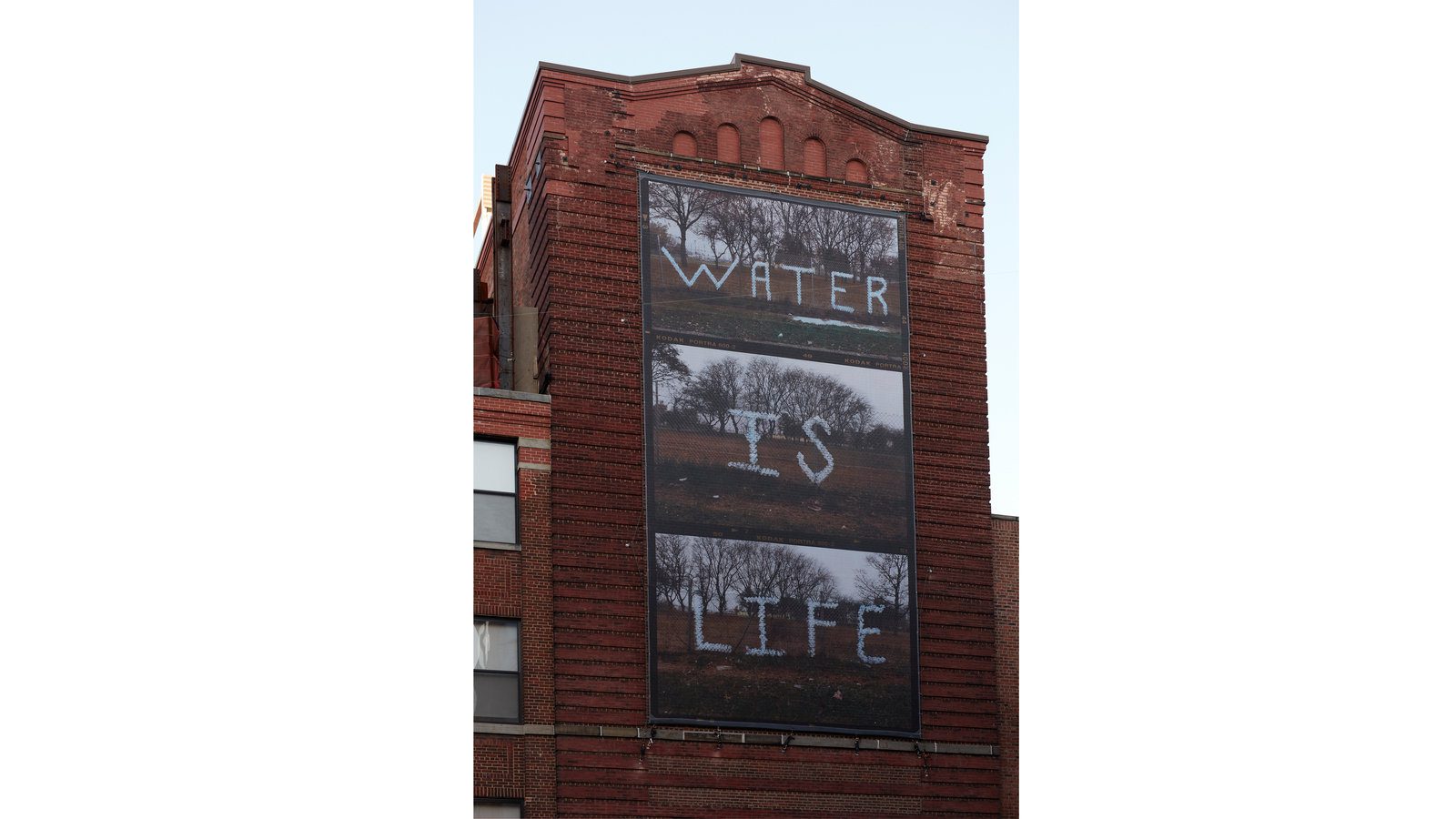In LaToya Ruby Frazier’s first commercial show in New York, the artist exhibits a series of photographs that document the life in Flint, Michigan, where water is hyper-visible and yet untouchable.

LaToya Ruby Frazier, Pat Brunty, the caretaker standing behind No Contest 1994, Noah Purifoy Outdoor Desert Art Museum, Joshua Tree, CA, Gelatin silver print (2017)
.
A color triptych of photographic negatives hangs in the place of a billboard outside the old brewery that houses the New York City gallery Gavin Brown’s enterprise. The message displayed through the enlargement and reprinting of the negatives reads, “Water Is Life.” The image is by the highly-acclaimed and accomplished photographer LaToya Ruby Frazier and is part of her first commercial gallery show. The exhibition preview is disarming. The image and its placement are powerful reminders of the environmental challenges that continue to inhabit underserved communities, and the ways that residents have elected to mark these spaces. It is only after viewing Frazier’s photographs inside the gallery that a visitor discovers that the residents of Flint, Michigan, used empty plastic bottles to express the stated message. For Flint residents, the message’s inverse, “Life Is Water,” appears to resonate more.

LaRoya Ruby Frazier, Installation view outside of Gavin Brown’s enterprise, 2017. Courtesy the artist and Gavin Brown’s enterprise.
The show spans three floors. The first floor is dedicated to the series “Flint is Family,” which originally appeared in Elle magazine. The series developed out of a collaboration between Frazier, Shea Cobb, a self-described bus driver, coach, singer, and songwriter, and members of Cobb’s family. The second-floor features pictures of Frazier’s hometown, Braddock, Pennsylvania, and her family that she took over a 12-year span and published in the book The Notion of Family (Aperture, 2014). The top floor includes photographs of Noah Purifoy’s Outdoor Desert Museum. There is an expansiveness to the show, giving it the feel of a retrospective.
Frazier aims to shift the script on documentary photography guided by a concern over how Florence Owens Thompson, the subject of Dorothea Lange’s image Migrant Mother, would have photographed herself and her family. Part of Frazier’s process involved conveying the awareness of her photographed subjects to the presence of the camera and how it represented them and their stories. There is the sense that the subjects of Frazier’s photographs are also looking at and observing gallery visitors. In this reproduction of The Notion of Family, Frazier and her pictured subjects invite visitors to examine their scars and tattoos. Frazier pictured Grandma Ruby sleeping on a recliner in front of a television set and then awake, looking into the camera. The pictures seen on the refrigerator door and coffee tables appear in the other frames.

LaToya Ruby Frazier, Grandma Ruby’s Stove Top, Gelatin silver print (2009). Courtesy the artist and Gavin Brown’s enterprise.
The towns of Braddock and Flint follow similar historical paths of development and degradation. However, as a visual subject, water is anything but transparent. The contamination of Flint’s water system dates to before 2013, when public uproar surfaced over cases of contamination attributed to the system’s privatization. People in Flint have to drive and walk over smelly and non-drinkable water on a daily basis. Large parts of people’s homes, like the kitchen, are unusable. Cobb and her daughter, Zion, travelled to a restaurant on the city’s outskirts to eat, and even there they were distrustful of the water. According to the photographs, people took to the streets behind the police tape when Obama visited in hopes that he would “see that the water is killing” them. The ways that subjects appeared within Frazier’s frames were a result of the techniques they had devised in order to live in a place where the water is hyper-visible and yet untouchable.

LaToya Ruby Frazier, Fifth Street Tavern and U.P.M.C. Braddock Hospital on Braddock Avenue, Gelatin silver print (2011). Courtesy the artist and Gavin Brown’s enterprise.
Flint’s story was all too familiar to Frazier, but she recognized it was not her story to tell. One of her photographs shows how she covered Obama’s visit to Flint from inside the home of Cobb’s uncle Rodney Clay. Through the television screen, Flint residents watched Obama drink the town’s water. Frazier drew out the irony of the moment by also photographing the painted murals that positioned Obama as a figure within a broader history of industrialization and civil rights – a dream distant from the reality pictured. She has paired exhibition prints with captions, some of which included text cited from the Association of American Physicians regarding the health risks Flint residents could experience. To further attune visitors to how Flint residents experience and take a stand against water’s dark side, Frazier produced multi-color prints using the cyanotype printing process and organized them into a collage. As a result, details emerge regarding the ways in which people, like Cobb’s cousins and Cobb herself, return to and leave Flint, the significance of events like weddings, and that the judge officiating a wedding that Cobb attended prosecuted town officials for mismanagement of the water facilities.
Drew Thompson is a visual historian and Assistant Professor of Historical and Africana Studies at Bard College.
More Editorial